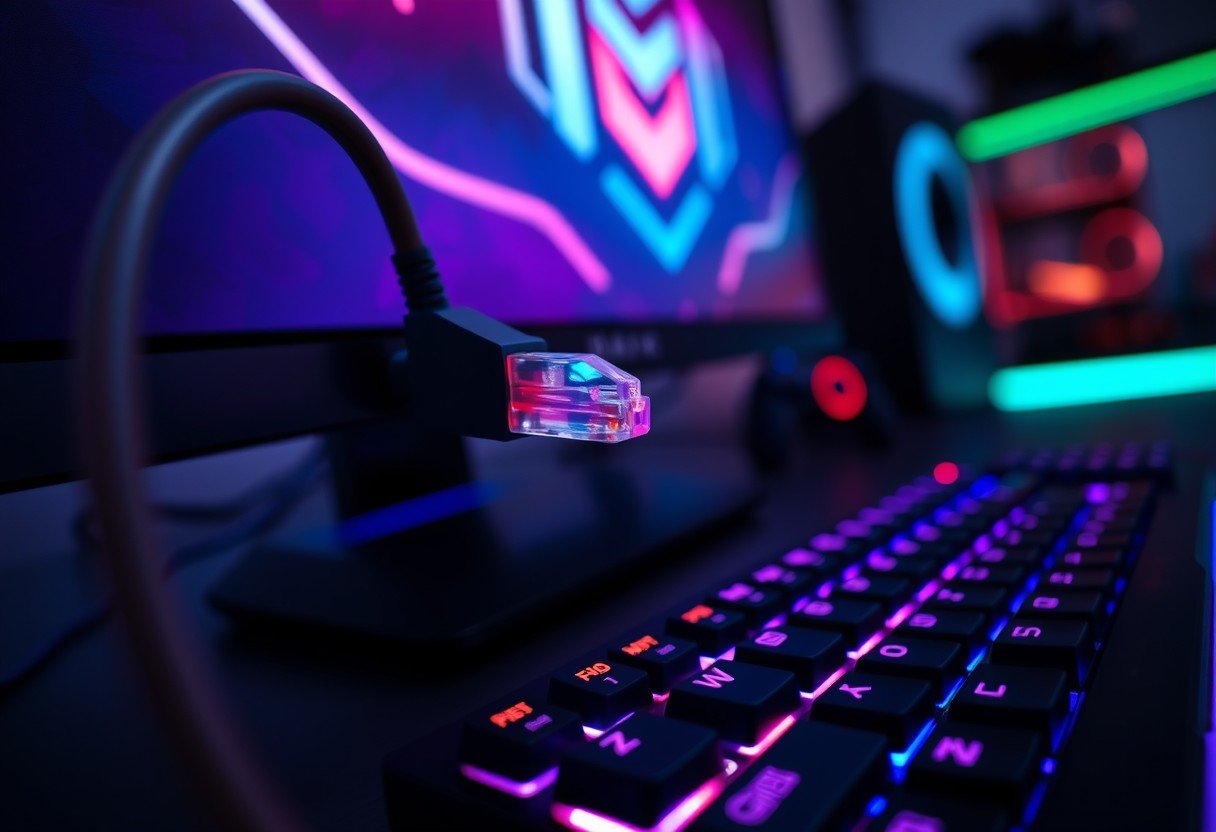If you’re a serious gamer, you know that a split-second delay can mean the difference between victory and defeat. While Wi-Fi is convenient, a wired Ethernet connection is the secret weapon for achieving the lowest lag and most stable speeds. Using an Ethernet cable directly links your gaming console or PC to your router, providing a reliable pipeline for data that wireless connections simply cannot match, giving you a crucial competitive edge.
Why a Wired Connection is a Game Changer
For online gaming, stability is everything. Wi-Fi signals travel through the air and can be weakened by walls, furniture, or interference from other electronic devices like microwaves. This can cause frustrating lag spikes, packet loss, and even disconnections right in the middle of a crucial match.
An Ethernet cable creates a direct, physical connection between your gaming device and your router. This hardwired link provides a consistent and uninterrupted flow of data, virtually eliminating interference and dropouts. You get the full speed you pay for from your internet provider, which is essential for downloading large games and updates quickly.
The result is a gaming experience that is smoother and more reliable. Your actions in the game happen almost instantly, giving you faster reaction times and a significant advantage in fast-paced, competitive games.
Understanding the Different Types of Ethernet Cables
Not all Ethernet cables are created equal. They are categorized by “Cat” ratings, which indicate their performance capabilities, such as supported speed and bandwidth. Choosing the right one depends on your internet plan and gaming needs.
For most gamers today, a Cat6 cable is the perfect balance of performance and price. It supports speeds up to 10 Gbps, which is more than enough for any current gaming application and most residential internet plans. Higher categories like Cat7 and Cat8 offer even more speed and better shielding against interference, making them great for future-proofing your setup.
Here is a simple breakdown of the most common cable types and their maximum speeds:
| Cable Type | Maximum Speed |
|---|---|
| Cat5e | 1 Gbps |
| Cat6 | 10 Gbps |
| Cat6a | 10 Gbps |
| Cat7 | 10 Gbps |
| Cat8 | 25-40 Gbps |
How Ethernet Directly Reduces Lag and Latency
In gaming, “latency” or “ping” refers to the time it takes for data to travel from your device to the game server and back. High latency causes noticeable delay, or lag, between your actions and what you see on screen. A wired Ethernet connection significantly reduces latency compared to Wi-Fi.
Because the connection is direct, data packets travel a more efficient and stable path. This leads to a lower and more consistent ping time, which is critical in competitive shooters, fighting games, and other genres where every millisecond counts. With lower latency, your character responds faster, you see enemies sooner, and your shots register more accurately.
Busting Common Myths about Gaming with Ethernet
There is a lot of misinformation about Ethernet cables that can confuse gamers. It’s important to separate fact from fiction to make the best choice for your gaming setup without overspending.
Many people believe you need the most expensive cable for the best performance, but this is rarely true for gaming. Here are a few common myths debunked:
- Myth: You need a gold-plated, high-end cable. Fact: For most gaming situations, a standard, well-made Cat6 cable provides the same performance as a premium-priced one. The category rating is what matters most.
- Myth: A long Ethernet cable will slow you down. Fact: Ethernet cables can maintain their maximum speed up to 100 meters (about 328 feet). For any normal home setup, cable length will have no noticeable impact on your gaming performance.
- Myth: Ethernet doesn’t matter with fast Wi-Fi. Fact: Even with the latest Wi-Fi 6 technology, a wired connection is still more stable and has lower latency. Wi-Fi will always be more susceptible to interference.
Ultimately, a reliable and affordable cable that meets the speed of your internet plan is all you need to get a top-tier gaming experience.
Simple Tips for the Best Ethernet Setup
Getting the most out of your wired connection involves more than just plugging in a cable. Proper installation and setup can ensure you receive the best possible performance and maintain a clean gaming area.
Start by placing your router in a central and elevated location if possible. While this is more critical for Wi-Fi coverage, it also helps keep your networking gear organized. When running your Ethernet cable, try to avoid bundling it tightly with power cords, as this can sometimes cause minor electrical interference.
Proper cable management not only looks better but can also prevent accidental damage to your cables. Use cable clips or ties to neatly route the wire along walls or under your desk. This keeps it out of the way and reduces the risk of it being bent or snagged, ensuring a long-lasting and reliable connection for countless gaming sessions.
Is Upgrading Your Ethernet Cable Worth It?
If you are still using an old Cat5 cable, upgrading can make a noticeable difference, especially if you have an internet plan faster than 100 Mbps. Moving to a Cat5e or Cat6 cable will allow you to take full advantage of gigabit internet speeds.
Investing in a higher-quality cable is also a smart way to future-proof your network. As internet service providers roll out multi-gig speed plans and games become more data-intensive, having a capable cable like a Cat6a or Cat7 ensures your setup is ready for the future. It’s a small, affordable investment that guarantees your network hardware won’t be a bottleneck for years to come.
Frequently Asked Questions
What type of Ethernet cable is best for gaming?
For most gamers, a Cat6 Ethernet cable is the ideal choice. It supports speeds up to 10 Gbps and offers a great balance of performance and affordability, easily handling the demands of online gaming and fast internet plans.
Does using an Ethernet cable really reduce lag?
Yes, absolutely. An Ethernet cable provides a more stable and direct connection to your router, which significantly lowers latency (ping) and prevents packet loss. This results in a much smoother, more responsive gaming experience with less lag.
Will a longer Ethernet cable affect my gaming performance?
No, not for typical home use. Ethernet cables are designed to work perfectly for distances up to 100 meters (328 feet) without any signal loss or performance issues. You can confidently use a cable long enough to reach your gaming setup without worry.
Can I see a speed improvement by upgrading my Ethernet cable?
Upgrading your cable can improve your speed, but only if your current cable is a bottleneck. For example, if you have a 1 Gbps internet plan but are using an old Cat5 cable (which maxes out at 100 Mbps), upgrading to Cat5e or Cat6 will unlock your full internet speed.
Is Ethernet better than Wi-Fi 6 for gaming?
Yes. While Wi-Fi 6 is incredibly fast, it is still a wireless technology susceptible to signal interference and instability. A wired Ethernet connection remains the gold standard for competitive gaming because it offers lower latency and unmatched reliability.







Leave a Comment